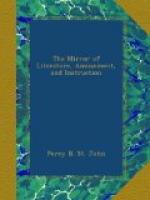This bird has been known to catch fish. Some years ago, on a fine evening in the month of July, long before it was dark, as I was standing on the middle of the bridge, and minuting the owl by my watch, as she brought mice into her nest, all on a sudden she dropped perpendicularly into the water. Thinking that she had fallen down in epilepsy, my first thoughts were to go and fetch the boat; but before I had well got to the end of the bridge, I saw the owl rise out of the water with a fish in her claws, and take it to the nest. This fact is mentioned by the late much revered and lamented Mr. Atkinson of Leeds, in his Compendium, in a note, under the signature of W., a friend of his, to whom I had communicated it a few days after I had witnessed it.
I cannot make up my mind to pay any attention to the description of the amours of the owl by a modern writer; at least the barn owl plays off no buffooneris here, such as those which he describes. An owl is an owl all the world over, whether under the influence of Momus, Venus, or Diana.
When farmers complain that the barn owl destroys the eggs of their pigeons, they lay the saddle on the wrong horse. They ought to put it on the rat. Formerly I could get very few young pigeons till the rats were excluded effectually from the dovecot. Since that took place, it has produced a great abundance every year, though the barn owls frequent it, and are encouraged all around it. The barn owl merely resorts to it for repose and concealment. If it were really an enemy to the dovecot, we should see the pigeons in commotion as soon as it begins its evening flight; but the pigeons heed it not: whereas if the sparrow-hawk or windhover should make their appearance, the whole community would be up at once, proof sufficient that the barn owl is not looked upon as a bad, or even a suspicious, character by the inhabitants of the dovecot.
Till lately, a great and well-known distinction has always been made betwixt the screeching and the hooting of owls. The tawny owl is the only owl which hoots; and when I am in the woods after poachers, about an hour before daybreak, I hear with extreme delight its loud, clear, and sonorous notes, resounding far and near through hill and dale. Very different from these notes is the screech of the barn owl. But Sir William Jardine informs us that this owl hoots; and that he has shot it in the act of hooting. This is stiff authority; and I believe it because it comes from the pen of Sir William Jardine. Still, however, methinks that it ought to be taken in a somewhat diluted state; we know full well that most extraordinary examples of splendid talent do, from time to time, make their appearance on the world’s wide stage. Thus, Franklin brought down fire from the skies:—“Eripuit fulmen coelo, sceptrumque tyrannis."[1] Paganini has led all London captive, by a single piece of twisted catgut:—“Tu potes reges comitesque stultos ducere."[2] Leibnetz tells us of a dog in




